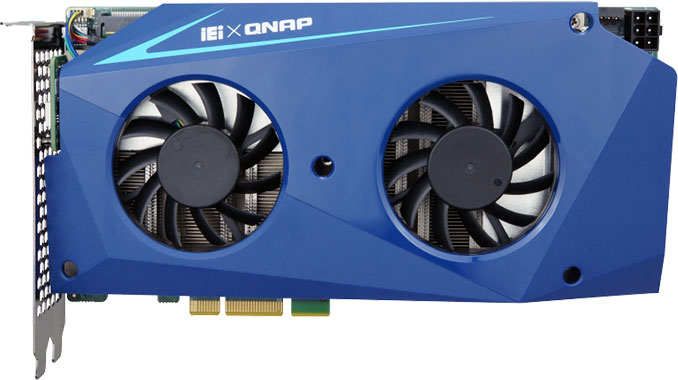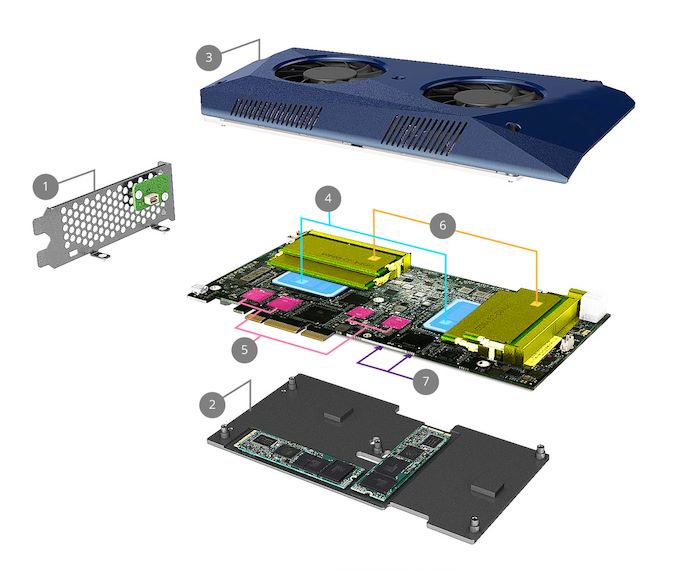QNAP Launches Mustang-200 Compute Accelerator for Network Attached Storage
by Anton Shilov on November 21, 2018 4:30 PM EST
QNAP has released a special-purpose accelerator based on two Intel CPUs that is designed to significantly boost the processing capabilities of NAS boxes and even PCs. QNAP’s Mustang-200 can speed up access to data located on a NAS box, but can also be used to increase image processing capabilities of NASes used for surveillance, run AI and ML apps, or speed up virtual machines.
The QNAP Mustang-200 accelerators are PCIe 2.0 x4 cards based on two Intel Kaby Lake CPUs (Core i7-7567U, Core i5-7267U or Celeron 3865U) outfitted with their own 4 - 16 GB of DDR4 memory as well as 512 GB Intel 600P SSDs (Core i5/i7 only). Each node has its own 10 GbE NIC and runs its own copy of QNAP’s mQTS operating system, thus offering a familiar functionality to those who use NAS products from QNAP.
By adding a Mustag-200 card, owners of QNAP NASes can increase the processing power of their systems from one processor to three, which can be used by a variety of applications supported by mQTS. Since the cards have their own resources, administrators can deploy different applications on different nodes using the Mustang Card Manager program and physically isolate them from each other. It is noteworthy that the Mustang-200 accelerators can be installed not only into NAS boxes, but also into regular PCs and be used for a variety of applications.
| QNAP Mustang-200 Cards | ||||
| CPU (x2) | RAM (per CPU) | SSD (per CPU) | ||
| Mustang-200-i7-1T/32G-R10 | Intel Core i7-7567U - 2C/4T, 3.5GHz, Iris Plus Graphics 650 | 16 GB | Intel 600p 512 GB |
|
| Mustang-200-i5-1T/32G-R10 | Intel Core i5-7267U: 2C/4T, 3.1 GHz, Iris Plus Graphics 650 | |||
| Mustang-200-C-8G-R10 | Intel Celeron 3865U: 2C/2T, 1.8 GHz, Intel HD Graphics 610 | 4 GB | - | |
| Compatible NAS Models | TS-2477XU-RP , TS-1677XU-RP, TS-1685, TS-1677X, TVS-1282, TS-1277, TVS-882, TS-877 | |||
| Notes | 1. The host NAS requires QTS 4.3.5 (or later). 2. TVS-1282 and TVS-882: Only models with 450W power supplies are supported. 3. TS-1685: Only models with 550W power supplies are supported. |
|||
QNAP’s Mustang-200 cards are now available to customers with compatible NAS machines. Prices have not been published yet.
Related Reading:
- QNAP Announces TS-332X Three-Bay NAS with 10 GbE
- QNAP Launches 16-Bay AMD Ryzen-Based TS-1677X NAS with 10 GbE
- QNAP Launches TS-963X NAS: x86 NAS With 9 Bays & 10 GbE/Multi-Gig Ethernet
Source: QNAP











28 Comments
View All Comments
CheapSushi - Thursday, November 22, 2018 - link
Maybe I missed it but any chance of it working with non-QNAP systems?notb - Thursday, November 22, 2018 - link
There's surely a chance, but it's not clear whether QNAP allows this.Generally speaking, it's 2 mini PCs on PCIe - both running QNAP OS. Both have separate RAM, small storage and network interface.
This add-on card doesn't make your NAS faster. The host system sees these 2 tiny PCs as separate servers on the network.
QNAP OS is a Linux, so it's just a question of replacing it another distro.
stanleyipkiss - Thursday, November 22, 2018 - link
The product page on the QNAP website says it works on regular PCs not just on QNAP NAS systems. I would even buy one, but it has no USB or video output. So I can't use it as a 2nd system in my PC.jab701 - Thursday, November 22, 2018 - link
"Each node has its own 10 GbE NIC and runs its own copy of QNAP’s mQTS operating system"It is as if each node is a full NAS one a PCI-E card. The PCI-E connection behaves as a 10GB NIC in this case, I guess it avoids having complicated PCI-E bridges between two PCI-E root hubs.
However, you can (with mQTS) run virtual machines (I believe) on these cards, so it would be like having you own cluster within your PC.
notb - Thursday, November 22, 2018 - link
Exactly. This card is basically 2 autonomous PCs. PCIe is there just to provide physical interfaces. There's actually a chance this could work not plugged into a PCIe slot (it has a separate reset button).The only problem is: you'll never know (apart from the moving fans), because there's no other way to connect to this thing
Klimax - Thursday, November 22, 2018 - link
Reminds me of old upgrade CPU cards.shabby - Thursday, November 22, 2018 - link
Which ones? I remember those overdrive cpus but never addin cards.piroroadkill - Friday, November 23, 2018 - link
Maybe he's thinking of Slot 1 and Slot A CPUs, or cache on a stick.DeathReborn - Friday, November 23, 2018 - link
Back in the olden days some motherboards had addon boards to upgrade the CPU like this one: http://www.asrock.com/mb/spec/upgrade.asp?Model=am...Kevin G - Sunday, November 25, 2018 - link
The Pentium II, early Pentium III's, early Xeons and early Athlon's all came on cards. The reasoning was cost as they all had a separate back side cache bus that would have added layers to the motherboard otherwise. This also gave Intel/AMD the opportunity to mix/match cache size easily.Apple was a big pusher of processor cards with their efforts predating the mainstream adoption from the PC side. They were also one of the few to leave them behind, arguably in 2013.
In the server space back in the day, many RISC systems came on cards. A handful of high end systems today still do so to increase RAS, reduce downtime etc.